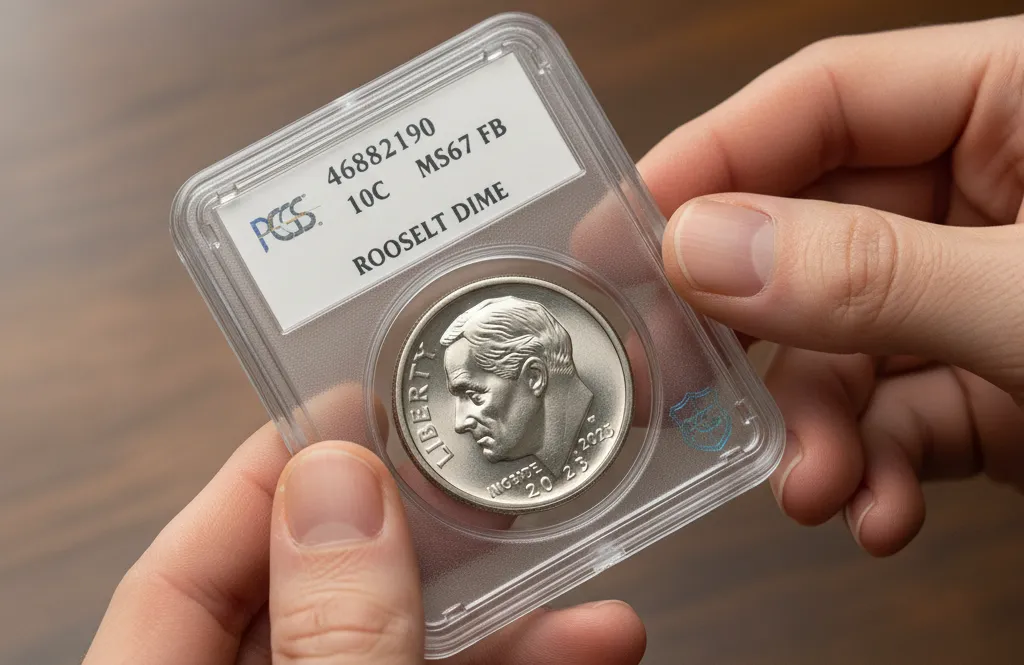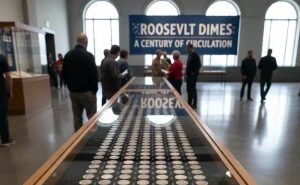Among the many series of coins, there are still some copies that are more expensive and popular, or they are very rare and therefore popular. One of these series is Roosevelt Dimes — the composition and at the same time the production conditions could change from year to year, and hence the number of rare errors.
In any case, besides the popular 1966 dime, there are other coins and common mistakes that are always heard by professionals.

The Story of the Design and Its Meaning
Remembering the President
Franklin D. Roosevelt died on April 12, 1945, before the war was over, and people soon decided they wanted to honor his memory by putting his picture on a coin.
They chose the dime, which is worth 10 cents, because it was a special and symbolic choice since Roosevelt started the National Foundation for Polio, and this foundation got a lot of its money from small donations, often just one dime.
Designing the Coin and John R. Sinnock
The important job of designing the coin was given to the Chief Engraver of the US Mint, John R. Sinnock, who had worked with the Mint since 1917, and he had also designed the medal for Roosevelt’s first time as president in 1933.
The front side of the coin shows a picture of Roosevelt’s face looking to the left, and many coin experts say this is one of the best president pictures on American coins because it looks strong and determined.
The word “LIBERTY” is written in a curve on the left side, and the motto “IN GOD WE TRUST” is at the bottom left, while the year the coin was made and the mint mark are written to the right of the portrait, and the designer’s initials “JS” are placed close to the bottom of the president’s neck.
The “JS” Problem: After the coin was released, there was a small but loud political argument because people who did not like Roosevelt falsely said that the initials “JS” belonged to a Soviet spy, but the Mint quickly told everyone this was wrong and officially said that the initials belonged to John R. Sinnock.
The back side of the Roosevelt Dime has strong pictures:
- A Torch is a symbol of Freedom and light
- An Olive Branch is a symbol of Peace
- An Oak Branch is a symbol of Victory and strength
These three symbols together show the message “Freedom, Peace, and Victory”, and they replaced the bundle of rods that were on the Mercury Dime, because even though the bundle was a traditional sign of Roman power, it had a bad connection with the fascist leaders in Europe by the middle of the 20th century.
The words on the back side include “UNITED STATES OF AMERICA”at the top edge, the motto “E PLURIBUS UNUM” and the value “ONE DIME” at the bottom edge.
Technical Facts and the Big Change in Metal
The Silver Time (1946–1964)
| Fact | Value (1946–1964) |
| Metal | 90% Silver, 10% Copper |
| Weight | 2.50 grams |
| Size | 17.91 mm |
| Edge | Has lines (118 lines) |
The Silver Problem and the 1965 Law
In the early 1960s, the price of silver started to go up very fast, which meant that the silver metal inside the dimes, quarters, and half-dollars was worth more than the face value of the coin itself, and this caused many people to take the silver coins out of spending.
To stop this problem, the US Congress made the Coinage Act of 1965, it ended the use of silver in dimes and quarters and started the use of Clad Coins.
The Clad Time (1965 – Now)
| Fact | Value (1965 – Now) |
| Metal | Outer Layer: 75% Copper, 25% Nickel Inner Core: Pure Copper Total Mix: 8.33% Ni, 91.67% Cu |
| Weight | 2.268 grams |
| Size | 17.91 mm |
Since 1992, the Mint has started making special silver Proof dimes again with 90% silver for collectors’ sets, but these coins are not meant to be spent.
The Mints and Where the Marks Are
- Philadelphia (P): The main Mint
- Denver (D): Uses the letter “D”
- San Francisco (S): Uses the letter “S”, mostly for special Proof coins after 1968
How the Mark Moved
1946–1964 : The mark (D or S) is on the back side, to the left of the bottom of the torch, but coins made in Philadelphia did not have a mark.
1965–1967: During these few years, the mint marks on coins used for spending were taken off for a short time to stop people from taking the silver coins and to hide how many coins were being made, even though they were still made in Philadelphia and Denver.
1968 – 1979 : The mark was moved to the front side, placed above the year, close to the bottom of Roosevelt’s picture, but Philadelphia coins still did not have a mark.
1980 – Now: Since 1980, the mark “P” has appeared on Philadelphia coins, which made the Roosevelt Dime the first American coin with a value less than a quarter to always have the “P” mark.
Collector Dates and Rare Conditions
Most Valuable Silver Dates (1946–1964)
The important silver dates are worth a lot not only because they have silver but also because it is hard to find them in very good condition (high grades).
- 1949-S: This dime, made in San Francisco, is one of the hardest to find in a new state with a clear, perfect strike
- 1955 (P, D, S): All three Mints made fewer coins in 1955
- 1950-S and 1951-S: Because the metal dies used in San Francisco in the early 1950s were old and worn.
Rare Coins from the Clad Time
- 1996-W (50th Anniversary): This coin was made to celebrate 50 years of the series, and these coins with the “W” mark were only put into special sets for collectors and were never used for spending.
Only about 1.45 million were made, so it is the only dime made at West Point.
The Meaning of Full Bands (FB)
The FB/FT mark is only given to coins where the horizontal lines on the torch on the back side are fully, clearly, and perfectly struck without any missing parts.
Finding a dime with this special mark is much harder than finding one without it because the lines on the torch were one of the weakest parts of the design and were often pressed flat or filled with metal — silver dimes and some clad dimes in MS-65 condition with the FB mark are worth many times more money than coins without it.
Most Valuable Mistakes and Differences
Mistakes with Missing Mint Marks
- 1975-S No-S Proof Dime: Only two known coins were made without the “S” mark.
- 1968-S and 1970-S No-S Proof Dimes: These similar mistakes on Proof coins are not as rare but still cost a lot of money.
- 1982 No-P Dime: This is the only known mistake with a missing mint mark on a spending coin from the clad time, because in 1982, the “P” mark should have been there.
The mistake happened because the die was either not engraved or the mark was taken off when the die was cleaned, so the 1982 coins without the “P” mark, especially the ones with a strong strike, are rare and wanted by many.
Doubled Die
- 1946-S Doubled Die Obverse: There is a clear doubling on the year and on parts of the president’s face
- 1964-D Doubled Die Reverse: A clear doubling can be seen on the words on the back side, especially on “ONE DIME” and “UNITED STATES OF AMERICA”
- 1960 DDO Proof and 1963 DDR Proof: These are valuable Proof coins with doubling mistakes
Repunched Mint Marks – RPM
- 1949-S/S: It is clear that the “S” mark was put on, then the tool moved, and the mark was hit again
- 1953-S/S: This is another example of the San Francisco mark being hit again
| Rare Type | Example Coins | Main Reason for High Value |
| Silver / Basic | 1946–1964 P, D, S | The silver metal inside the coin |
| Key Dates | 1949-S, 1955, 1950-S | A small number were made and it is hard to find them in high grades |
| Clad Rarity | 1996-W | Special coin set, only a few were made |
| Rare Condition | Any year with the FB/FT mark | The torch is perfectly struck and looks new |
| Spending Mistakes | 1982 No-P, 1964-D DDR | A mark is missing, or image is double |

Collecting the Roosevelt Dime: Tips and Plans
For many people, the dimes from 1946–1964 are a popular way to buy silver because they are easy to know and they definitely have real silver inside.
It is quite easy to collect a full set of coins from every year and every Mint (Date and Mint Mark Set), but the biggest problem is finding the coins from the first years (1946–1964) in very high grades and looking perfect.
It is important to know that after 1965, the quality of the dies and the coin making was often not very good because they were making so many coins, and this led to many rare conditions.
Coins from the 1960s, 70s, and 80s, which usually only cost the face value, can be worth hundreds or even thousands of times more if they have a perfect strike (FB).
How to Buy And Sell Roosevelt Dimes
To Buy
The safest places to buy are authorized coin dealers and large coin exhibitions. These sellers often provide guarantees of authenticity and vouch for the grades assigned to them.
Sites like eBay or specialized numismatic forums are for finding specific dates or inexpensive bulk shipments of silver. But always check the seller’s reputation and reviews before making a purchase and be careful of non-certified expensive coinage errors.
For the most valuable coins — the 1965 No S Proof or the MS-68 silver issues — the main source is large numismatic auction houses.
Buy any coins that you consider valuable, usually more than $100 only from certified third-party grading services such as PCGS or NGC, as the certification provides an objective assessment of the safety and confirms the authenticity of the coin.
To Sell
If you have common clad dimes or low-grade silver, selling to a local coin dealer is the fastest option, although you will probably get a wholesale price.
Silver ones are often sold as bullion lots to metal dealers or investors, with the price directly linked to the spot price of silver.
For rare coins like 1982 No P or 1949-S in a high degree of preservation, consider sending them for consignment to a major auction house — it takes longer and involves commission fees, but can result in a higher selling price due to competitive bidding.
Before selling any coin that you suspect of being rare or valuable, get an independent appraisal, knowing the true safety and value of your coin is making the best possible deal.
So, among one series there are tokens that are more valued, and there are those that are underestimated.
In any case, try to get into the habit of visiting offline auctions and exhibitions more often than online in order to develop visibility and monitor the quality of tokens with the naked eye.





